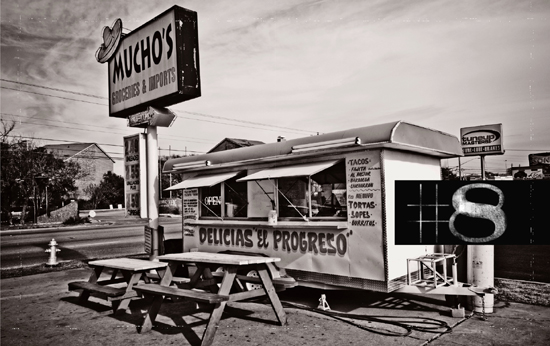
An idyllic setting for a taco-trailer picnic on South Lamar in Austin
The bistec taco at the Jarro trailer on Gessner Drive in West Houston came with Angus sirloin, sliced paper-thin without a thread of gristle, grilled well-done, and layered on two lightly fried corn tortillas. On the stainless-steel counter that runs along the front of the trailer, there were salsas and condiments in six molca-jetes, the three-legged Mexican bowls typically used as mortars.
I grabbed a fat lime quarter from one bowl on the shelf and squeezed it over the top of the steak. I skipped the bright orange chile de árbol salsa and the neon green serrano slurry. This time I wanted to try a dark-chocolate-colored salsa made with dried chiles in oil with a dash of orange juice for sweetness. For a topping, I spooned up some “Mayan escabeche,” electric purple onion slices marinated in lime juice, flecked with Mexican oregano and chile powder.
I folded the two tortillas around the meat and condiments, cocked my head to one side in the time-honored taco eater’s pose, and took a huge bite. The meat was so tender, it dissolved on my tongue. The juicy beef melded with the familiar flavors of corn tortilla and lime juice. The raw-flavored dried chile salsa came on like mole poblano’s punk-ass cousin. And the juicy raw onions added some crunch.
It was one of the most impressive tacos I ate in the six months of writing the “Taco Truck Gourmet” column for the Houston Press food blog. I have eaten a lot of tacos while writing about taco trucks, carnecerias (Mexican meat markets), and taquerias over the past few years.
The trucks are interesting places to eat Mexican food in Hispanic cities like Los Angeles and my hometown of Houston. But in formerly virgin taco territories such as Portland, Seattle, New Orleans, and New York City, taco trucks and the newly opened hole-in-the-wall taquerias are selling the best Mexican food in town.
A taco truck in line for cleaning at the Southwest Commissary in Houston—the health department requires a visit every twenty-four hours
The “Taco Truck Gourmet” Blog got started one morning when I tried to get breakfast at the famous taco trailer called Taqueria Tacambaro behind the Farmer’s Marketing Association produce terminal on Airline Drive. The proprietress, Maria Rojas, didn’t have any egg tacos. She said she only had fajitas. I pointed to a pile of white things on the griddle and asked her what they were.
“Mollejas,” she replied, which is Spanish for sweetbreads. The incongruity of eating a dish I associated with French haute cuisine from a taco truck made me grin. Just for kicks, I ordered a taco stuffed with sweetbreads and topped it with raw onion, cilantro, and salsa. The fluffy, barely-cooked-through sweetbreads, hot off the griddle, were the best I have ever eaten in Houston.
Maria Rojas told me that she served the same food at her taco trailer that you would find at the little puestos (food stalls) in the mercado of her hometown of Tacambaro in Michoacán. She chose her location near the fruit and vegetable stands of the Farmer’s Marketing Association because it is the closest thing to a Mexican mercado you can find in Houston.
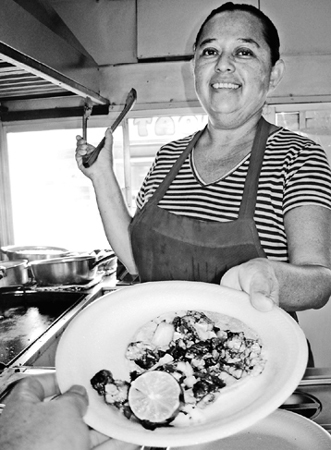
Maria Rojas and her knockout sweetbread tacos at the Farmer’s Marketing Association in Houston
I might never have tried the taco de mollejas at Taqueria Tacambaro, if they hadn’t been the only thing available. The experience convinced me that there were some hidden treasures out there. So I decided to make a concerted effort to find the best taco trucks in the city.
I already knew that there was nothing inherently wonderful about taco truck food. It can be better than, worse than, or just the same as the food in a taqueria or a Mexican restaurant. But there are some fundamental differences.
Taco trucks are operated by immigrants for immigrants. And this makes them a fascinating culinary phenomenon. First of all, because they are serving some items that no other venues offer. And secondly, because they challenge high-minded ideas about authenticity.
Taco-truck fare is defined by the Mexican-style taco, which is comprised of two lightly fried corn tortillas stuck together, and then filled with some kind of meat. The price ranges from a dollar to two dollars each, with the vast majority falling smack in the middle at $1.50.
On Texas taco trucks, you always find barbacoa (beef cheek meat), pork carnitas (little bits of pork), and tacos al pastor. Breakfast tacos and hamburguesas are also popular. But by far the most common offering is fajitas—various papain-tenderized cuts of beef that meat purveyors sell very cheap.
The taquero will ask if you want raw onion and chopped cilantro, which is generally free. For the second tier of garnishes, an additional option of lettuce and tomato, there is generally a small charge. Jalapeños, sometimes pickled but more often roasted, are also available for a pittance. Salsas range from the simple to the elaborate; they are always free and are always applied by the consumer.
Variations include other corn dough platforms, such as gorditas, chalupas, or sopes, which go for two to three dollars. Flour tortillas are sometimes available for an extra twenty-five cents, and they are occasionally homemade. The oversized Mexican sandwiches called tortas are priced at five to six dollars. I have also seen Frito pie and nachos on taco-truck menus, but Tex-Mex crispy tacos and cheese enchiladas are notably absent.
There are also specialists. Pollo asado (roasted chicken) is offered by brightly painted school buses with names like Regio or Norteño that suggest the owners come from Monterrey. The chicken trucks are equipped with mesquite grills and turn out an excellent whole chicken dinner that comes with a roasted onion, peppers, salsas, and tortillas for ten dollars.
Even though the cooks and the customers are mostly Mexican immigrants, it would be a mistake to assume that taco trucks serve authentic Mexican food. Goat is the most common meat in the Michoacán mercado stalls, Maria Rojas told me. I have had taco-truck birria (stewed goat) a couple of times, but it’s not very often that you see goat meat on a taco truck in Texas.
But you can’t say that taco-truck food is entirely Americanized, either. Maria Rojas’s tripe and sweet-breads tacos are exactly the kind of food that newly arrived immigrants will go out of their way for. These are the kind of tacos that might impress Mario Batali and Anthony Bourdain, who are big into offal dishes.
Since few of my dining companions like sweetbreads and tripe, I took my friend Bernard Brunon, an artist from France, to Taqueria Tacambaro. He was utterly amazed. And then he started taking other Frenchmen and visitors from France to eat tripe tacos there. Now photos of Taqueria Tacambaro are turning up in French art publications. I predict this taco trailer will someday be listed in French travel guides.
The concept of the taco truck isn’t as new as it seems. Fresh tortillas, fried tortilla chips, and Mexican snacks were delivered door-to-door by horse and buggy in San Antonio in the 1800s. Tamale carts and other mobile food vendors were also very common in Texas before the sanitary laws of the Progressive Era were enacted in the early 1900s and shut them down.
The first actual taco trucks in Texas were Model T Fords. A 1939 black-and-white photograph (shown above) by the famous WPA photographer Russell Lee captured the details. It’s titled “Mexican lunch wagon serving tortillas and fried beans to workers in pecan shelling plant, San Antonio, Texas.”
In the photo, the taco vendor squats in the back of a Model T pickup truck with a cardboard box full of tortillas. His customers take the desired number of tortillas and make “self-serve” tacos from a selection of fillings in metal pots arrayed along the edge of the open tailgate. It illustrates a unique solution to the lack of handwashing facilities: el taquero, the taco man, never touches the tacos.
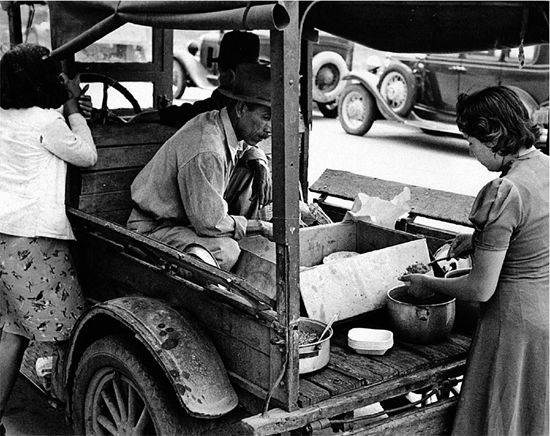
The Jarro taco trailer on gessner has become legendary among taco-truck owners. This is the most successful taco truck in the city. It does so much business that its owner, Guillermo “Memo” Piñedo, has opened a freestanding restaurant, called Jarro Café, right beside it.
There are guys who eat lunch at the trailer during the week, and then bring their families for a sit-down meal in the restaurant on the weekend. Jarro also serves tacos al pastor, made with marinated pork and the Yucatecan specialty, cochinita pibíl, which is marinated pork cooked in banana leaves. While you can get tacos al pastor at almost any taco truck in the city, the bistec (steak) tacos and the cochinita pibíl are unique. And so are the unusual salsas.
“There weren’t any taco trucks around here when we started,” said Memo when I ran into him at the trailer. “Now there are taco trucks all up and down Gessner.” They are trying to duplicate Jarro’s success. “But they don’t get it. It’s the quality of the food, not the location, that made this taco trailer successful,” he said.
I sat down with Guillermo Piñedo and his wife for an interview. The couple once ran a three-location chain of Jarro Café restaurants in Mexico. The original location was in Mexico City, the other two were in the beach resort communities of Ixtapa and Cancún. The devaluation of the peso in the Carlos Salinas era crippled their finances. Then Memo Piñedo was kidnapped.
“That was when we decided to get out,” Señora Piñedo remembered.
The original idea was to come to Houston and open a restaurant. But the Piñedos didn’t know much about the city, and that made it difficult to pick a location. The real estate negotiations, financing, and permit processes were also daunting. A friend of theirs who worked as a chef at a Houston restaurant suggested they consider a taco truck instead.
At first they dismissed the idea. They had never seen a taco truck in Mexico, so it was hard to imagine. But their friend drove them around to see a few in Houston and they began to realize the brilliance of the concept. If your location isn’t working out, you move somewhere else, observed Memo.
The Piñedos invested $25,000 in a trailer and another $5,000 for everything else they needed. Their $30,000 investment was a tiny fraction of what it would cost to start a restaurant. And they had no loan payments to make. They paid several hundred dollars a month to rent a location in front of a liquor store on Gessner, but they had few other expenses.
Business was slow at first. “Memo only sold three kinds of tacos,” said Señora Piñedo. “Steak, cochinita pibíl, and al pastor.”
The bistec sold at most Houston Mexican restaurants is tough as shoe leather and riddled with gristle, so nobody was interested in a steak taco from a taco truck. And few of the laborers and immigrants who make up the majority of taco-truck customers had ever heard of the slow-cooked Mayan pork dish called cochinita pibíl.
“I ended up giving a lot of tacos away for free,” Memo recalled.
And there were the weird salsas. Taco trucks, like taquerias, usually offer red and green sauce. Heat levels vary, but you seldom taste anything as hot as Jarro’s orange chile de árbol or bright green serrano salsa in Houston. His friends pleaded with him to offer conventional fajita tacos and regular salsas, Memo recalled.
“Owners of other taco trucks asked me why I was paying two dollars a pound for sirloin when you could get fajita beef for a dollar a pound. I said, ‘America has the best beef in the world, why not put it on a taco?’ They thought I was crazy. But I wasn’t going to sell what every other taco truck was selling,” said Memo. “I was going to sell the kind of food we had at our restaurants in Mexico. I was going to do it my way.”
Within three months, word of mouth about the sirloin tacos and the super-hot salsas had spread and the Jarro taco trailer on Gessner was swamped with customers. “I had to hire four workers to keep up with the orders,” Memo said. Jarro taco-trailer workers all wear uniforms, and the trucks are sparkling clean and painted in striking black with very professional graphics.
Behind the Jarro Café, there are two brand-new taco trailers that Memo has recently ordered. He intends to expand his brand with franchisees. Why franchise taco trailers instead of restaurants? “Because the trailers are cheaper, easier to run, and more profitable,” Memo said.
“It’s crazy to have a taco trailer out front in the parking lot competing with your restaurant, huh?” Memo said with a laugh. But there’s no way he would close it. The trailer makes as much money as the restaurant.
Why don’t the taco-trailer customers come inside?
“There are lots of reasons,” Memo explained. Some loyal outdoor customers are laborers who don’t have time to change clothes and clean up. It’s also faster outside, and it’s twenty-five-cents-a-taco cheaper.
“It’s my drive-through window,” he joked.
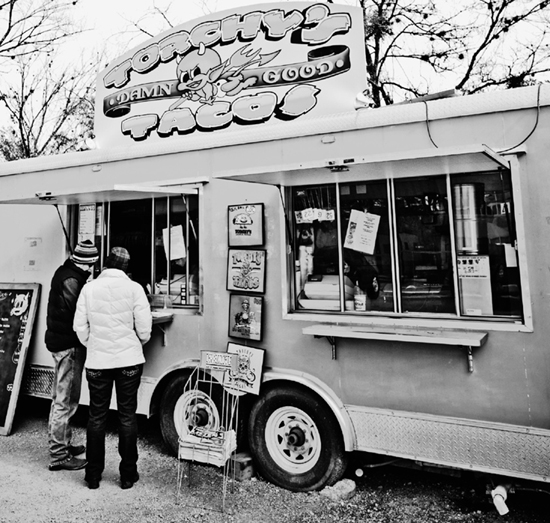
Old-fashioned taco trucks inspired a new wave of cutting-edge street food from mobile kitchens such as Torchy’s Tacos in Austin
The Super Tacos truck at Ninety-sixth and Broadway on the island of Manhattan has been in the same spot for almost twenty years. “It used to be an older truck, and it used to be only tacos,” a customer who was waiting in line told me. He had been eating here for twelve years. I ordered the dinner special, which was chicken in mole sauce, six tacos with various meats, and two sopes.
Then I hailed a cab and climbed into the back seat with my large white sack. I had told Jane Daniels Lear, then my editor at Gourmet, that to wrap up my taco-truck article, I would pick up dinner at a Manhattan taco truck for her and her husband. As I headed across town to her fashionable East Side apartment, I began to question my sanity. I had never eaten anything from the Super Tacos truck before. What if the food wasn’t any good? What if I poisoned her?
For a long time, Super Tacos was the only taco truck on the entire island of Manhattan. In 2006, another one, called Taco Express, moved to 145th Street in Harlem. But it was a third truck, called El Ídolo, from Corona, Queens, that got all the attention. It started swooping into Manhattan late at night and parking on Eighth Avenue and Fourteenth Street in the trendy Meatpacking District when the bars were closing. Hip young New Yorkers got a taste, and suddenly taco trucks were the buzz. Now they are all over New York.
“Taco trucks are adored because they are totally unpretentious,” Manhattan Mexican chef Aaron Sanchez told me. “You eat with your hands.” Sanchez, who authored La Comida del Barrio, used to frequent the taco trucks in his hometown of El Paso. In New York, he likes a trailer called Taco Guicho at Roosevelt Avenue and Eighty-fourth Street in Queens for the sopes.
When I got to my editor’s place, I unloaded the sack and arranged the goodies on wooden cutting boards so we could split them at the table. There was so much ohhing and ahhing that I figured I was pretty much off the hook.
Taco trucks are popping up all over, and their impact should not be underestimated. At first glance, the taco truck seems like a fusion of modern American automotive culture and inexpensive Mexican street food. But in fact, the taco truck is a Trojan horse.
What they are sneaking in is the invasive culture of antojitos, those inexpensive, satisfying corn-based snacks topped with grilled meats and chile sauces. Once you start eating this stuff, you’re hooked.
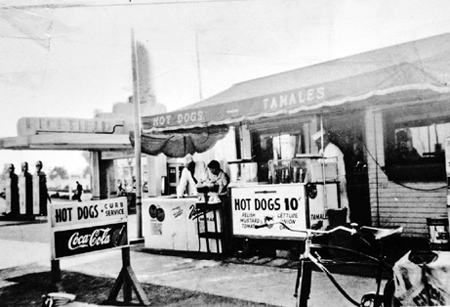
Pink’s Hot Dogs in Los Angeles started out as a pushcart in 1939
5 GREAT TACO TRUCKS IN PORTLAND, OREGON
In 2007, the late great Gourmet magazine hired me to write a story about taco trucks across the country. I had already eaten at lots of taco trucks in the Southwest, but the story gave me a chance to sample food from taco trucks in Portland, Seattle, New York, and New Orleans.
I was shocked to discover how good the taco-truck food was in Portland, Oregon. Thanks to the artisan food movement, Portland liberalized health department regulations to allow certification of home kitchens. The same laws that made it possible for artisan bakers, chocolate makers, and canners to sell homemade wares at farmer’s markets also made it possible for Portland taco trucks to sell Grandma’s soup and pot roast.
Here are five of my favorite Portland taco trucks.
TACOS Y TORTAS MORELIA
FOSTER AND SE 52ND AVENUE
Don’t miss Morelia’s pambazo sandwich. The roll is dipped in dark dried chile sauce, then toasted on the griddle and stuffed with shredded homemade beef pot roast, cheese, potatoes, carrots, onions, lettuce, tomato, and sour cream. It’s a whole pot roast dinner on a slippery chile-coated roll.
EL BRASERO
SE 12TH AVENUE AND HAWTHORNE BOULEVARD
On the El Brasero trailer, there is a sign that reads RICA BARBACOA ESTILO D.F. That means Mexico City–style braised lamb shoulder cooked until it falls apart. It’s served on corn tortillas and topped with chopped onion, cilantro, a squeeze of lime juice, and homemade green salsa. A Styrofoam cup of hot consommé comes on the side. Dip your taco in the hot spicy lamb broth and eat it while it is hot and drippy.
LINDO MICHOACAN
33RD AVENUE AND SE DIVISION STREET
The lusciously gelatinous braised beef cheek at the Lindo Michoacan truck at 33rd and Division tasted just like the Tex-Mex barbacoa we eat back home. I took my photo of the tacos at the communal picnic table nearby. This is the most popular taco truck in Portland and the most egalitarian. I watched a woman in a green designer coat and matching handbag get in line behind some Spanish-speaking guys in work boots, gimme caps, and sweatshirts to order lunch. I am sure the fresh handmade tortillas are part of the draw at Lindo Michoacan, but the fact that the truck is parked in a hip residential neighborhood close to downtown doesn’t hurt, either.
LA CATRINA (TORTAS GIGANTES)
9694 SE 82ND AVENUE (NEAR OTTY)
(BOB’S AUTO & GAS)
The ten-dollar torta cubana is a Mexican-style Cuban sandwich. It is only by virtue of the adhesive properties of melted American cheese that the layers of ham, steak Milanese, head cheese, scrambled eggs, a hot dog split into lengthwise quarters, tomato, avocado, pickles, jalapeños, and onions all stick together on the toasted bolillo. The sandwich is majestic.
MEXICO LINDO
ALOHA SHOPPING CENTER
18565 SW TUALATIN VALLEY HIGHWAY, ALOHA, OREGON
Try a foot-long flat taco called a huarache (it means “sandal” in Spanish) at the Mexico Lindo truck in the parking lot of the Aloha Shopping Center. You can barely see the refried beans and grilled meats on top of the freshly made masa (corn dough) for all the lettuce, tomato, radishes, white cheese, and sour cream on top.
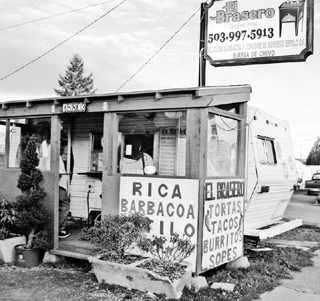
Mexico City–style barbacoa at a trailer in Portland
Vegetable oil
Corn tortillas
VARIATION
GRIDDLE-ROASTED CHILE PEPPERS, TOMATOES, AND ONION SLICES
A good taquero doesn’t waste grill space. When you are going to grill some meat or fish outside on the grill, bring along some whole, fresh jalapeños or serranos, tomatoes, and onion slices and roast them on the grill in a frying pan placed on the grill while the rest of the food is cooking.
Two 6-ounce filet mignons
¼ cup freshly squeezed lemon juice
¼ cup olive oil
4 cloves garlic, minced
2 tablespoons New Mexican chile powder or other pure chile powder
Sea salt to taste
FOR SERVING
1 cup All-American Guacamole
8 tortillas (see Taquero-Style Tacos)
4 tomato slices
½ cup crumbled Mexican white cheese
8 black olives, sliced
4 sprigs fresh cilantro
Bottled hot sauces
#1 JARRO CAFÉ
IN FRONT OF JARRO CAFÉ
1521 GESSNER DRIVE
What to get: Don’t miss the steak (bistec) taco made with thin-sliced Angus sirloin. Also recommended: the Campechana (beef and chorizo), cochinita pibíl (slow-cooked pork), and beef-and-mushroom tacos. Flour tortillas are available for a little extra. Don’t miss the salsa bar. The dark-green jalapeño-and-cilantro salsa may be the mildest; the dried chile salsa is complex and picante. Only the most dedicated chile-heads should attempt to ingest the incendiary orange chile de árbol sauce and the rip-your-lips-off neon green serrano slurry. The food is a little cheaper and a little faster at the taco trailer, but they have the same tacos inside the air-conditioned restaurant, where you also get chips, ice water, knives and forks, and an expanded menu.
2520 AIRLINE DRIVE (BEHIND CANINO’S)
What to get: Tacos de mollejas and tripitas (sweetbreads and tripe) are amazing. If you don’t like offal, try the spicy pork al pastor, crisped up in a frying pan and served with raw onion and cilantro, and the awesome gordita, made with a thick masa cake split in half, then stuffed with homemade refried beans and Mexican cheese. Don’t miss the roasted jalapeños. Mexican nationals come from miles around to eat Maria Rojas’s home-style Michoacán cooking.
#3 EL ULTIMO
7403 LONG POINT ROAD
(SOUTHWEST CORNER OF LONG POINT ROAD AND ANTOINE DRIVE)
Look for a shiny new taco truck parked in front of a car wash. The sanitary standards are exceptional. Both the man and woman behind the counter were wearing hair nets. What to get: The breakfast tacos are a dollar apiece, and they’re huge. They come with your choice of scrambled eggs with bacon, ham, potatoes, nopalitos, machacado (shredded beef), chorizo, or roasted peppers on a corn or flour tortilla. The flour tortillas are handmade, and the chorizo is truly exceptional. The thick green salsa is pretty hot and the red is a little tamer. There’s no coffee, but there are fresh-fruit aguas frescas available. Don’t be suprised if the truck isn’t there; it goes to the commissary for cleaning and restocking frequently.
#4 EL NORTEÑO
LONG POINT ROAD AND GESSNER DRIVE
This is a “chain” with a couple of blue school buses and at least one blue trailer. They change locations often, but they can usually be found around the corner of Gessner and Long Point. At this writing, there is a blue bus on Gessner north of Long Point and a blue “El Norteño” truck out in front of the shopping center at 9893 Long Point. What to get: Pollo asado estilo Monterrey is their specialty—six dollars for half a chicken, ten dollars for a whole one. Both come with tortillas, a roasted onion, chiles, and condiments. The chicken is good, but costillas al carbón—a whole slab of grilled spare ribs with onions, chiles, and condiments for fifteen dollars—are even better. A half slab, which goes for $7.50, is more than enough for two.
#5 TACOS TIERRA CALIENTE
1300 BLOCK OF MONTROSE BOULEVARD IN THE “WE FIX FLATS” PARKING LOT
Maria Samano and her flirtatious crew from the “hotlands” of Michoacán run this extremely popular taco trailer in the Montrose. What to get: barbacoa tacos with onions and cilantro. Ask Maria for the “salsita,” and she’ll hand you a squirt bottle full of her creamy green “hotlands hot sauce.”
El Ultimo taco truck in Houston serves awesome breakfast tacos
1 to 1½ pounds beef mollejas (sweetbreads)
1 tablespoon salt
1 cup vinegar
Six 6-inch wooden skewers, soaked in water for 15 minutes
FOR SERVING
8 tortillas (see Taquero-Style Tacos)
Salsa of your choice
½ cup chopped onions
1 tablespoon minced fresh cilantro
Juice of one lime
The Tacos Gaby’s truck was parked on Hope Street, near the Lowe’s building-supply store on the edge of the French Quarter. The taco truck’s customers, most of them laborers on lunch break, sat in folding chairs or on the curb.
After Katrina, an army of Spanish-speaking immigrants arrived in New Orleans to rebuild the city, causing stand-up comic George Lopez to quip that FEMA stood for “find every Mexican available.” The sudden arrival of a major Latin American population in New Orleans was a fast-motion version of the immigration pattern that’s taken place in other cities and towns over the course of decades.
Wearing a baseball cap and eating a quesadilla al pastor on the curb by the Tacos Gaby’s truck was chef John Currence from City Grocery in Oxford, Mississippi. Currence is a New Orleans native and he spent an enormous amount of time doing volunteer work in New Orleans after Katrina.
“For a good while after the hurricane, the taco trucks were the only places to eat,” said Currence. “It’s honest, handmade food, and it’s a dollar twenty-five a taco.” The grilled meats, hot-off-the-griddle tortillas, and fresh pico de gallo served at the taco trucks was a huge improvement over what used to pass for Mexican food in New Orleans.
I struck up a conversation with the twenty-two-year-old man who was running the taco truck. He told me he had traveled to New Orleans two months after Katrina hit. He had found plenty of construction work, but nothing to eat. So he had called his parents, who operated a taco truck in Houston, and told them to come to New Orleans. They brought the truck over and business was so good, the whole family decided to relocate. They have lived here ever since. They still take the truck back to Houston to buy groceries and Mexican sodas.
In Mexico City, tacos al pastor are made from pork that is cut from a revolving “trompo” of meat on a vertical roaster
¼ cup granulated garlic
1 tablespoon cider vinegar
1 teaspoon dried oregano
1 teaspoon powdered chile
1 teaspoon freshly ground black pepper
Pinch of ground cumin
Salt
2 cups freshly squeezed orange juice
1 tablespoon achiote paste (optional)
2 pounds boneless pork loin, thinly sliced
½ pineapple, peeled, cored, and cut into long, thick strips
FOR SERVING
12 tortillas (see Taquero-Style Tacos), warmed
4 ounces grated jack cheese, mozzarella, or shredded
Oaxacan string cheese
4 flour tortillas
4 teaspoons butter
4 ounces meat filling, hot (optional)
VARIATIONS
DELUXE QUESADILLAS
Put 1 cheese-topped tortilla on the bottom and one without cheese on the top and proceed as directed, omitting the foldover step. Cut the finished quesadilla into quarters with a sharp knife. Garnish with guacamole and cilantro.
GRILLED QUESADILLAS
You can also heat quesadillas on the grill grate, but be careful to make sure the cheese has melted and is holding the contents in place before you flip it over.
2 large telera rolls (or substitute torpedo rolls)
4 slices muenster or provolone cheese
½ cup Refried Beans
FILLINGS OF YOUR CHOICE
4 well-done fried eggs (optional)
4 thin tomato slices
4 thin onion slices
¼ cup mayonnaise (in a squeeze bottle if possible)
Pickled Jalapeño slices, optional
1 large avocado, thinly sliced
The sandwich maker at this Matamoros torta shop cuts the tortas in half with an electric knife on the flat top
8 cups hot water
½ cup sea salt
3 tablespoons Tabasco or other hot sauce (or more to taste)
1 tablespoon freshly ground black pepper
1 tablespoon poultry seasoning
1 can beer
1 whole fryer chicken, 3 to 4 pounds
Oil, for frying
¼ cup Red Rub
3 cups Italian dressing such as Wishbone
1.5 liters Jarritos Mandarin soda (1 large bottle)
4 cloves garlic
½ cup sea salt
4 bay leaves
2 serrano chiles, cut in half lengthwise
10 peppercorns
2 half chickens, 1 chicken cut in 8 pieces, or 4 leg quarters
¼ cup Red Rub
VARIATION
For tamarind chicken, use Jarritos Tamarind soda, or use any other cane-sugar-sweetened soda that sounds like it would be a complement to roasted chicken.
It was a blustery day in Seattle when I climbed aboard the big white school bus called Tacos El Asadero on Rainier Avenue South. There I found people seated on round stools at stainless-steel counters that ran along both sides of the front half of the bus. The kitchen and the cashier’s stand were in the back.
Taco trucks change their shapes and sizes to suit their locales. In Texas, where pick-up trucks are common, the taco trailer is becoming increasingly popular. In New York, where parking is a nightmare, the taco pushcart has emerged. And in rainy Seattle, taco lovers sit inside a “taco bus” to stay out of the rain.
I called chef Jesse Thomas of the Crow Restaurant and Bar when I got to town and asked him about Seattle taco trucks. The taco trucks started arriving in Seattle about six years ago, Thomas told me. And Seattle chefs were among the first to embrace them. “You line up with the workmen to eat. And that’s a beautiful thing,” he said. “One of my favorite things to do on my day off is go sit in the [El Asadero] taco bus.”
The hamburger patties at Hamburguesas Del Rio in Monterrey are seasoned with garlic salt and Worcestershire sauce and mixed with bread crumbs and eggs
To understand exactly what the term hamburguesa estilo Monterrey meant, I visited the Hamburguesas Del Rio location at Avenida Constitución 1121 Pte. Centro in Monterrey. From the Monterrey-style burgers I’d had in Houston, I assumed that the term described a specific set of garnishes, namely a white-bread bun topped with shredded lettuce, chopped onion, sliced tomato, then a hamburger patty, a slice of ham, and sliced avocado.
But I was wrong. A couple of bites revealed that there was something altogether different about the hamburger patty itself. So I asked the hamburguesero what went into the meat mix. Migas (bread crumbs), huevos (eggs), and garlic salt were among the ingredients he named. I have since found recipes online that include those items as well as salsa inglés (Worcestershire), soy sauce, and other seasonings.
When you order a hamburguesa from a taco truck or taqueria in Houston, you usually get an Americanized version of the hamburguesa estilo Monterrey: regular all-beef hamburger patties dressed with slices of ham and avocados in addition to the usual lettuce, tomato, and mayonnaise. It’s an excellent adaptation.
You find lots of other Latino burger variations in Texas, too, including the green chile cheeseburger of El Paso, the bean burger of San Antonio, and Mexico City’s hamburguesa estilo D.F., which comes with ham and a pineapple slice on top of the burger patty. The hamburguesa torta, or “tortaburger” that’s served on taco trucks and at taquerias often comes on fresh-baked telera bread (see recipe).
Unfortunately, most Latino burgers come with thin, flavorless, previously frozen burger patties cooked well done. That’s a problem that’s easy to fix when you make them in your backyard. Put one of your own big fat homemade burger patties in these recipes and you’ll have a helluva Tex-Mex burger in your hands.
Homemade Ground Meats While it sounds like a big project, the truth is making your own ground meat is pretty simple—if you have a meat grinder. You can grind venison, wild boar, duck, or other game and use it in all kinds of recipes without paying a lot of money to a wild game processor, too.
When grinding your own beef, look for chuck, round, brisket, or sirloin that’s on the fatty side. If you make the Tex-Mex Churrrasco you will find yourself with around three pounds of fatty tenderloin trimmings that are perfect for this purpose. Likewise you will get a lot of trimmings if you cut your own rib-eye steaks.
But if you are using chuck or round, odds are you won’t be close to a 70:30 meat to fat ratio. Which is why you will probably want to supplement the fat content of your ground meat. There are lots of ways to do this: you can add beef fat, salt pork, or any variety of fat you can find. But my favorite method was devised by the late great Tookie’s, a hamburger joint in Seabrook, Texas, that was closed by Hurricane Ike in 2008.
Tookie’s “Squealer” was a burger with bacon ground up with the beef. It’s easy enough to throw a few slices of bacon in the grinder if you are grinding up your own hamburger meat anyway. And you’ll love the flavor.
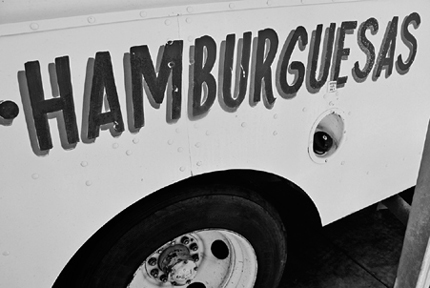
SOmetimes taco truck hamburguesas come on hamburger buns, and sometimes they come torta-style on telera bread
2 pounds chuck, round, or sirloin
6 ounces bacon
VARIATIONS
Use 1 pound beef and 1 pound venison, lamb, or goat meat along with the bacon.
HAMBURGER HELP
Grocery stores label ground beef with a ratio of meat to fat. “80-20” means 80 percent meat, 20 percent fat. You need fat to keep your burger juicy. The idea that lean meat is somehow superior has really messed up the hamburgers in this country. It’s not unusual to see “90-10” ground sirloin or even “93-7” in the grocery store. With so little fat, this kind of meat dries out quickly on the grill—especially if you take the USDA’s advice and cook your burgers to 160˚F.
Old-time butchers used to recommend a 70:30 ratio for a really juicy burger, and chefs in fine-dining restaurants are reviving this practice. Chef Bryan Caswell in Houston told me he started making the tiny hamburgers called sliders as bar snacks to use up his fatty rib-eye steak trimmings. The sliders became so popular Caswell now has two slider restaurants called Little Bigs in addition to Reef, his award-winning Houston fine-dining restaurant.
If you like your burgers rare, Caswell recommends that you grind your own burger meat (see Homemade Ground Meats). Top chefs who love burgers also recommend that you hand-pack well-seasoned, fatty burger meat at the last minute. Flip it as seldom as possible. And most importantly, resist the temptation to push down on top of the burger patty with a spatula, because doing so will force all the juices out.
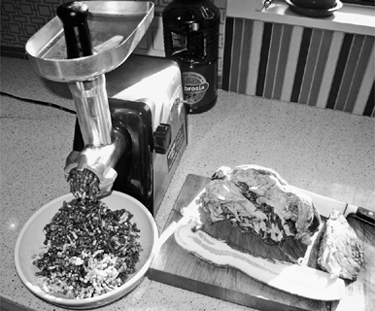
1 cup shredded jack cheese, divided
1 teaspoon minced green chile, or fresh or Pickled Jalapeños
3 pounds ground beef
1 envelope Lipton onion soup mix
2.25-ounce can chopped black olives
1 tablespoon Worcestershire sauce
1 egg, lightly beaten
¼ cup grated parmesan cheese
2 pounds ground beef
1 tablespoon Tex-Mex Grill Blend
1 tablespoon minced garlic
1 tablespoon minced serrano chile
1 teaspoon Worcestershire sauce
VARIATION
Add ½ cup grated jack, cheddar, or other cheese and proceed as directed.
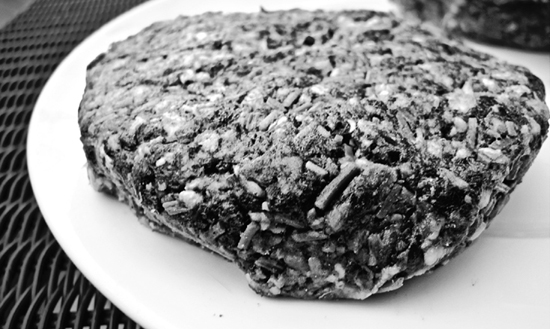
To make a stuffed cheeseburger, make a pocket in the patty and put some extra cheese or other stuffings in the middle, then seal it back up
2 large telera bread rolls
4 slices Swiss or provolone cheese
4 Tex-Mex Burger Patties, size of your choice
½ cup Refried Beans
4 well-done fried eggs (optional)
4 thin tomato slices
4 thin onion slices
½ cup mayonnaise (in a squeeze bottle if possible)
Pickled jalapeño slices
1 large avocado, thinly sliced
This tiny storefront on the side of a busy Monterrey street offered fresh eggs, hot dogs, hamburgers, tostadas, and Pepsi
4 Tex-Mex Burger Patties, size of your choice
4 hamburger buns
2 tablespoons butter
½ cup mayonnaise
1 cup shredded lettuce
½ cup finely chopped onion
4 large tomato slices
4 thin slices ham
1 large avocado, thinly sliced
Pickled jalapeño slices, optional
4 Tex-Mex Burger Patties, size of your choice
4 hamburger buns
1 cup warm Refried Beans
Medium-size bag of corn chips (such as Fritos)
Pickled jalapeño slices or salsa of your choice
1 cup Chile con Queso or Cheez Whiz
¼ onion, minced
BEAN BURGERS
The most unique Tex-Mex burger is the San Antonio bean burger. In his book Hamburgers and Fries, John T. Edge devotes an entire chapter to the San Antonio invention. The bean burger and its Tex-Mex embellishments “define the burger as Texan, while paying homage to the Mexican roots of the state’s people,” Edge wrote. He goes on to compare the bean burger’s sense of place with that of Washington State’s cedar-planked salmon.
Tex-Mex bean burgers should not be confused with California’s vegetarian bean burgers, in which beans are a replacement for the meat. The San Antonio bean burger is a regular hamburger patty with refried beans studded with Fritos corn chips. The original, which was invented at Sill’s Snack Shack in 1953, was then topped with Cheez Whiz and raw onions. There are many variations.
The Fritos sound like a terrible idea, but they make the bean burger sing. The soft beans and crunchy corn chips add a new level of textural interest to the hamburger. And Fritos were invented in San Antonio, after all. There are a lot of ways to go with the cheese. Most hamburger joints that make bean burgers use American or cheddar these days.
At Mama’s Café in San Antonio, the beans and Fritos are on the bottom bun, then comes a thick slice of purple onion. Next comes a quarter-pound burger patty topped with a standard square of American cheese. Guacamole and salsa are served in plastic cups on the side so you can add them or not as you prefer.
4 teaspoons mayonnaise
1 teaspoon Tabasco or other hot sauce
Juice of 1 lemon
4 all-beef wieners (fat ones work better than long ones)
4 slices extra-thin bacon
4 torpedo rolls or bolillos
4 tablespoons warm Refried Beans
8 tablespoons chopped avocado (or guacamole)
4 heaping tablespoons grated jack or cheddar cheese or
substitute Chile con Queso
4 tablespoons chopped onion
4 tablespoons chopped tomato
4 tablespoons Salsa Verde
The Sonoran hot dog at James Coney Island in Houston starts with a frankfurter wrapped in bacon